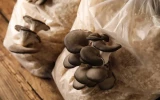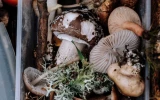How Long Do Spawn Bags Take to Colonize?
Spawn bags are popular among mushroom growers despite requiring longer commitment because they produce large flushes. If you want to grow mushrooms using this material, you’re probably wondering how long you must wait for your first flush. I will explain how long it takes for spawn bags to colonize substrates as you read in this article.
Complete colonization of spawn bags may take anywhere from 30 to 45 days depending on the strain of mushrooms, the temperature of the growing environment, and the quality of the bags. You will know they’re fully colonized when it is covered in white fluff, no grains are visible, and the bag is firm to the touch.
You will find more tips below on how to speed up the colonization process of spawn bags and what factors affect its rate. If you're still not convinced about resorting to spawn bags, we have listed some more advantages of using them.
Summary
- The colonization of spawn bags takes at least 30 - 45 days in general. The exact run time of mycelium growth depends on the strain of mushrooms, the temperature of the environment, and the quality of the bags.
- Minimal air exchange and less light exposure help aid in a more speedy colonization process.
- The use of spawn bags to induce colonization of mushrooms provides many benefits. They are convenient to use, easy to handle, movable, and help increase mushroom yield.

On this page:
Colonization of Spawn Bags Take 30 - 45 Days
Spawn bags take between 30-45 days to become fully colonized. Factors such as the strain of mushrooms used, the quality of the spawn bag, and the temperature of the growing environment play a major role in how long this process takes.
Some bags become fully colonized within two weeks, such as with oyster mushrooms. Some take up to six weeks like shiitake mushrooms. If you use highly durable spawn bags, you can expect faster colonization. You may want to keep an ideal temperature of about 75–80 °F (24–27 °C) to help speed up the process.
What sets apart spawn bags from other growing methods is that they provide a convenient way to grow mushrooms. It’s ideal for those who like to start mushroom-growing even in the comfort of their home.
They don’t occupy a lot of space as they are simply just plastic bags filled with a substrate of choice. You could use a mixture of grains, such as rye or wheat, and other materials like vermiculite or sawdust as substrate.
Once the bag filled with the substrate is sterilized, you may inoculate it with a mushroom culture which you can even make on your own. The inoculated mycelium will then grow through the bag, breaking down its nutrients in a process called colonization.
It will continue to grow until it has fully colonized the substrate, at which point it is ready for the next stage. It will be transferred to a larger container filled with a bulk substrate, like straw or compost, where the mushrooms will be encouraged to fruit.
But before the transfer, I highly recommend checking if the mycelium is ready to fruit. The most obvious sign of complete colonization which you could look for is a dense off-white material covering the whole bag.
To avoid contamination and guarantee a healthy fruiting process, perhaps you can wait until the substrate's uncolonized portions are completely covered.

Factors That Affect Colonization Time
While it typically takes 30 – 45 days for the mycelium to cover the whole bag, you can hasten the process by applying the following tips:
Use a high-quality spawn
The quality of the spawn used in the bags can impact the rate of colonization. You might want to make sure that the spawn bags you purchase are fresh, durable, and contamination-free.
If the bag is not durable enough to hold the pressure of the growing mycelium, you may experience a slower colonization time.
Optimize temperature for faster colonization
Most mushroom species colonize spawn bags best at temperatures between 75 and 80°F (24 and 27°C). Different mushrooms have different temperature requirements as follows:
- Oyster mushrooms: 75°F
- Button mushrooms: 75°F to 77°F
- Shiitake mushrooms: 60°F to 75°F
If you can keep the temperatures within this range, you'll surely have faster colonization.
Provide proper ventilation
Although spawn bags do not typically need air, providing a bit of air exchange can help prevent the buildup of carbon dioxide inside. You could allow air exchange by choosing bags with filter patches, which allows fresh air to pass and filters the contaminants.
Inoculate with a higher concentration of spawn
Inoculating the bag with a higher concentration of spawn can help speed up colonization time. However, be cautious not to use too much spawn, as it can also increase the risk of contamination.
Avoid over-saturating the substrate
Too much moisture can slow down the colonization process. If the substrate in the spawn bag is too wet, it can create anaerobic conditions which encourage the growth of bacteria and other microorganisms that can compete with the mushroom mycelium for resources.
Keep the bags in a dark location
Light is not needed during the colonization of spawn bags. It will be best if you can keep them in a completely dark room to encourage the growth of mycelium.
Provide a sterile growing environment
Contaminants can slow down or stop mycelium growth, and one way you can prevent this is by sterilizing all tools, equipment, and the substrate bag. Sterilization is one of the seven hacks you can perform for faster mycelium colonization.

Benefits of Using Spawn Bags in Colonization
Using spawn bags simplifies the colonization process and increases the likelihood of a successful harvest. If you’re still thinking if these bags are worth your time, here are a few more of their benefits:
-
They are convenient to use. Spawn bags are easy to use and can be stored until needed, making them convenient for home growers and commercial operations alike. Sterilized grain bags are known to last for several months if stored properly.
-
They are consistent. Using spawn bags allows for consistent colonization times and high success rates since the substrate and spawn can be thoroughly mixed.
-
They can be easily sterilized. Spawn bags can be sterilized using a pressure cooker or autoclave, ensuring that they are free of contaminants and ready to be inoculated with spores or mycelium.
-
They can help increase yield. They allow for even distribution of spores or mycelium throughout the substrate, resulting in faster colonization and better growth.
-
They are movable and easy to handle. Spawn bags are easy to handle and can be moved around as needed, making them ideal for growers with limited space.
Signs That Your Spawn Bag Has Completed Colonization
Now that you know how long you must wait for spawn bags to colonize, your next question might be: how do you know when your bags are fully colonized? You’ll know when you see the following signs:
White, fluffy mycelium:The bag will be covered in white, fluffy mycelium if the colonization has finished. This white covering should be distributed uniformly in the entire bag.
No visible grains: When your spawn bags are fully colonized, you will not be able to see any visible grains. If you can still see grains, it means that the mycelium has not fully colonized the bag yet and you must wait longer.
No smell: The bags should not have any strange or unpleasant smells. If they do, it could be a sign of contamination.
Firm to the touch: The substrate bag is completely colonized if it feels firm to the touch. A soft or mushy bag can indicate contamination.
When you confirmed that your spawn bags are fully colonized, you can proceed with the next step in your mushroom-growing process. This may involve breaking up the colonized grain and transferring it to a substrate or fruiting chamber.




